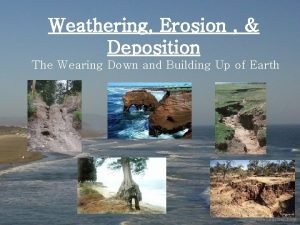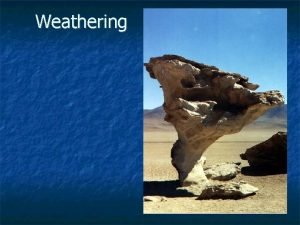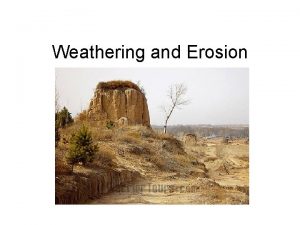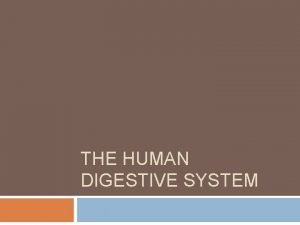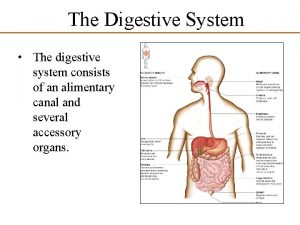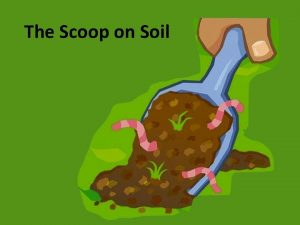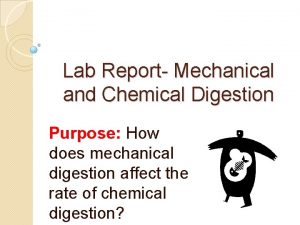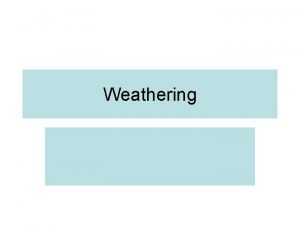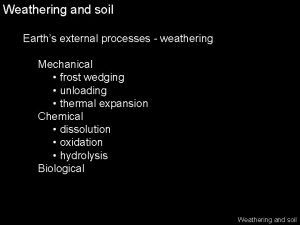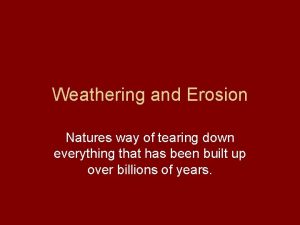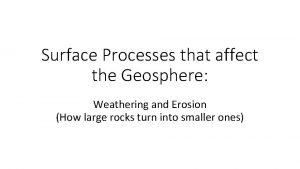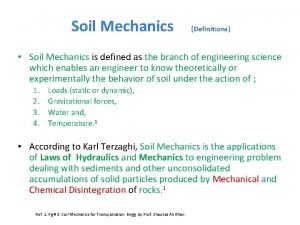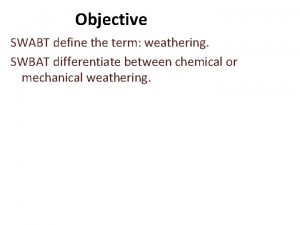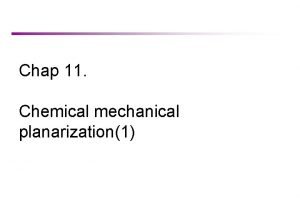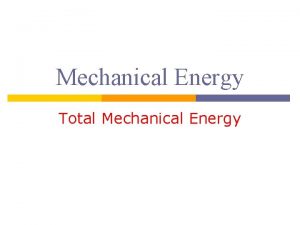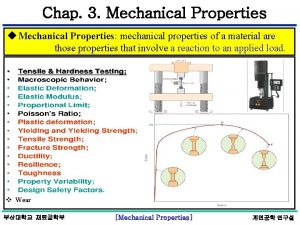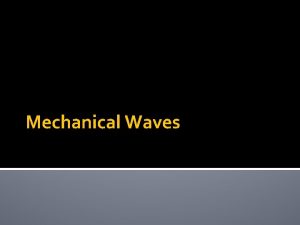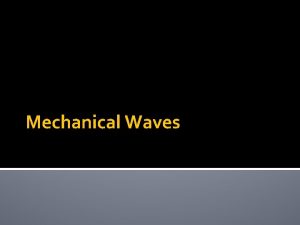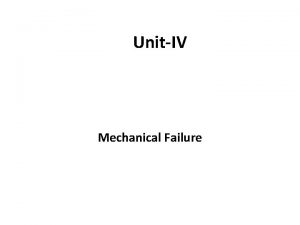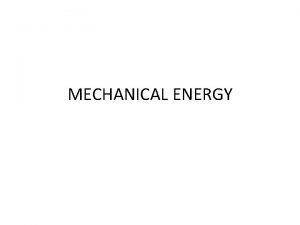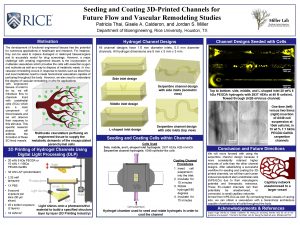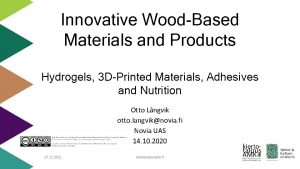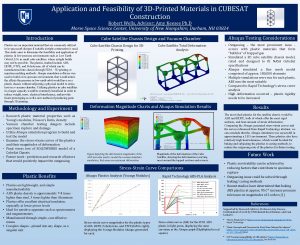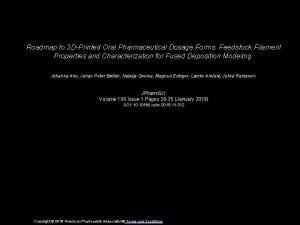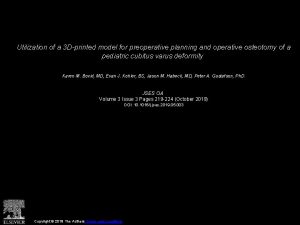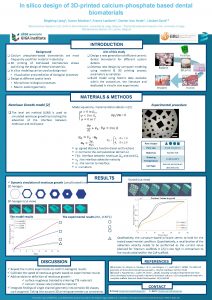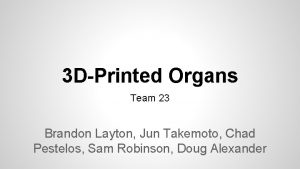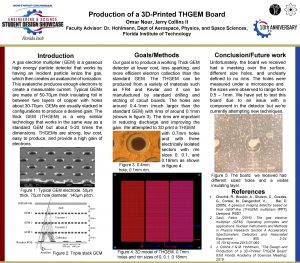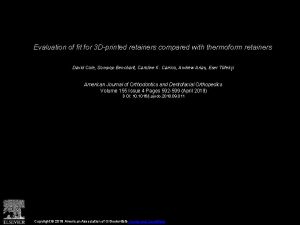The Mechanical and Chemical Response of 3 DPrinted
























- Slides: 24

The Mechanical and Chemical Response of 3 D-Printed Poly Lactic Acid to Gamma Irradiation from a Cobalt-60 Sterilizer Dr. Robert Mc. Taggart South Dakota State University Physics Colloquium, Wichita State University October 31, 2018

Rationale for the study 3 D-printing allows one to design and make replacement parts to exacting specifications when needed, particularly when stand-alone replacement is required. The reliability of these products after irradiation, say in space or after gamma sterilization, is often of interest. This is a collaborative effort among faculty in Physics, Mechanical Engineering, and Chemistry at SDSU.

Why Poly Lactic Acid? Poly Lactic Acid (PLA) is a biodegradable polymer that can be manufactured from biomass feedstocks. It is suitable for use as a thermoplastic in 3 D-printing. A combination of heat and irradiation could play a role in degrading plastics like these more quickly in the future.

Why gamma irradiation? • Cobalt-60 is used copiously in industrial sterilizers. • The gamma rays of 1173 ke. V and 1332 ke. V can provide a dose inside volumes, not just on the surface. • It does NOT make the material radioactive. • It does however break chemical bonds and foster things like cross-linking and oxidative processes. • And we could have access to irradiation services for free. https: //www. nordion. com/wpcontent/uploads/2014/10/GT_C-188_Co 60_brochure_PCCS 030 B. pdf

MTS 370 Landmark Tests for tension, compression, and bending. Fatigue studies for biomedical/biomechanical testing, soil and asphalt testing, general purpose component fatigue testing, plastics testing, composites testing, etc. Fracture mechanics, coefficient of thermal expansion. Specifications: Dynamic load rating: +/-22, 000 lbs (+/-100 k. N) http: //www. sd-metlab. org

MTS 858 Bionix Table Top System Specifications: Dynamic load rating: +/-5, 500 lbs (+/-25 k. N) Torsional Capacity: 250 Nm Suitable for testing biomedical fatigue of joint replacements. • • Yield and ultimate strength Creep and viscoelastic characteristics High and low cycle fatigue characteristics Fracture toughness and fracture mechanics Modulus of elasticity Wear characteristics Coefficient of thermal expansion

MTS Insight 5 Material Testing System Specifications: Dynamic load rating: 1125 lbf (5 k. N) This electromechanical material testing system can be employed in a wide variety of tests, including tensile, compression, flex, and peel-tear studies for: • • • biomedical and biomechanical testing plastics testing, composites testing, elastomer testing, wood and paper testing advanced material characterizations.

NSI X-View M 5000 -CT Computed Tomography System This system is an X-ray Inspection and Computed Tomography system designed specifically for industrial applications. This system utilizes an NSI radiation shielded enclosure and NSI M 5000 seven-axis component manipulator, an NSI X-View IW image processing workstation with high resolution flat panel detector with 225 k. V microfocus Xray system. This system is high resolution digital X-ray imaging technology.

Procedure Samples were 3 d-printed and tested to ASTM standards for plastics testing. We then irradiated samples with up to 200 kilo. Gray of gamma irradiation before performing mechanical and chemical testing. The material responses were then fit to a phenomenological model. Note: Sometimes more than one function worked. We chose the one with the lowest chi-square per degree of freedom. Still had a few degrees of freedom to play with.

Stress-Strain Testing The slope in the linear portion of the graph is called the Young’s modulus https: //www. nde-ed. org/Education. Resources/Community. College/Materials/Mechanical/Tensile. htm

Ultimate Strength: The largest stress observed during a tensile test

Yield Stress: Beyond this point, the response is no longer elastic in nature. • Different parameters, but the same form of the modified Fermi-Dirac formula provided the best fit.

Tensile Modulus of Elasticity • The modulus of elasticity increased with the radiation dose. • Thus the effective spring constant did not stay as a constant, resulting in a stiffer material.

Maximum elongation • This measures the elongation that occurs prior to failure. • We find that an exponential function worked the best. • This means that the sample fractures at a shorter stretch as the dose increases.

Flexural testing For the maximum flexural yield stress, or bending stress, PLA exhibited a similar response to the tensile testing. Different parameters, same modified Fermi-Dirac test function.

Modulus of Rupture • The modulus of rupture is the point at which the sample breaks down during the testing. • There is a bit of a statistical difference at 50 k. Gy however.

Modulus of Flexure • Similar in nature to the modulus of elasticity. • Hard to fit this particular curve due to the error bars. • However a parabola yielded the best fit. • Would say that there is some nonlinearity in the response of the material.

Maximum bending strain • As in the case of the tensile testing, failure occurred at a progressively smaller extension of the material. • This degradation occurs via a smooth exponential decay in both tensile and bending tests.

FTIR • The absorption of infrared light occurs via molecular bonds, which can be spring-like stretch, or twist via a torsion. • The 3350 cm-1 is hypothesized as the result of an O-H stretch, and the 2950 cm-1 is a C-H stretch. • These are the result of chainscission of PLA into other groups (like hydroxyls and alkyls).

FTIR • We found new FTIR lines that (a. ) did not appear in the control, and (b. ) is at the very least not common in the literature. • We hypothesize that the 3 -d printing process facilitated their generation. • What is not shown is that higher doses tended to destroy these lines, i. e. degradation > crosslinking.

Differential Scanning Calorimetry One aspect of introducing disorder into the polymer via irradiation is that phase transitions may occur at lower temperatures. We see this for different transitions in the study of polymers. At right we show the reduction in the melting temperature of the irradiated PLA samples.

Conclusions We see evidence of cross-linking in the non-linearity of the Young’s modulus and the new bonds in the FTIR. For the first 50 k. Gy or so, there is no real mechanical difference on PLA. There is some mild chemical impact though. But as the dose increases, degradation processes upon a very long PLA molecule from gamma irradiation take their toll. The FTIR spectra get destroyed, and the DSC data show the extent of the degradation.

Future directions This area has been good for publications, but has not translated into grants/contracts yet. Research for impacts on actual biomedical or industrial devices (including NASA) and ties with industry are of interest. Impacts of both heat and irradiation need to be explored. Can low doses provide beneficial cross-linking to tune the desired biodegradability of these plastics in the environment?

Acknowledgments Todd Letcher, Fereidoon Delfanian and everyone in METLAB at SDSU. Douglas Raynie and the Department of Chemistry and Biochemistry for DSC, TGA, and other chemical studies. The 3 M Corporation for gamma irradiation services and dosimetry. The SDSU Physics Department for funding when necessary. Dr. Solomey and the Department of Physics at Wichita State University for their gracious invitation for this talk and collaboration in neutrino physics.
 Compare and contrast mechanical and chemical weathering
Compare and contrast mechanical and chemical weathering Causes of weathering
Causes of weathering Natural and forced response
Natural and forced response What is natural response
What is natural response Primary immune response and secondary immune response
Primary immune response and secondary immune response Chemical weathering
Chemical weathering Weathering erosion
Weathering erosion Mechanical and chemical weathering venn diagram
Mechanical and chemical weathering venn diagram Difference between mechanical and chemical digestion
Difference between mechanical and chemical digestion Mechanical and chemical digestion
Mechanical and chemical digestion Chemical and mechanical digestion
Chemical and mechanical digestion Mechanical and chemical weathering venn diagram
Mechanical and chemical weathering venn diagram Mechanical and chemical weathering
Mechanical and chemical weathering Physical hazards
Physical hazards Difference of mechanical and chemical digestion
Difference of mechanical and chemical digestion Chemical and mechanical digestion venn diagram
Chemical and mechanical digestion venn diagram Dissolve
Dissolve Examples of mechanical weathering
Examples of mechanical weathering Chapter 10 weathering and soil formation answers
Chapter 10 weathering and soil formation answers Venn diagram of mechanical and chemical weathering
Venn diagram of mechanical and chemical weathering Mechanical and chemical weathering venn diagram
Mechanical and chemical weathering venn diagram Freeze thaw is an example of what type of weathering
Freeze thaw is an example of what type of weathering Soil mechanics
Soil mechanics Types of weathering
Types of weathering Chemical weathering examples
Chemical weathering examples

